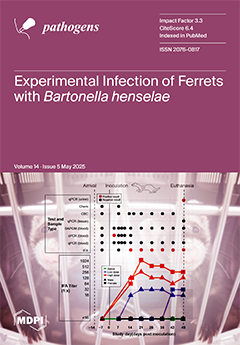Background:
Neisseria meningitidis (
N. meningitidis) is a leading cause of acute meningitis and is classified into 13 serogroups, six of which are predominantly associated with invasive meningococcal disease. This study aimed to investigate the genotype, subgenotype, and antigenic profiles of
N. meningitidis serogroup B strains isolated in Vietnam. Methods: Genotyping was performed on 106
N. meningitidis strains isolated from clinical samples from Vietnamese patients and nasopharyngeal
swabs of healthy adolescents between 2019 and 2024. The genetic profiles, including the porA, porB, fetA, fHbp, abcZ, adk, aroE, fumC, gdh, pdhC, and pgm genes, were analyzed using Sanger sequencing and bioinformatic methods. Results: We found that 84.9% of the strains carried VR3 families 36 or 35-1, with VR1, VR2, and VR3 families 22-25, 14, and 36 being the most prevalent. Among the 106 serogroup B isolates, 20 variants of the porB allele 3 were identified, with porB 3-1212 being the most frequent (30.2%). Dominant PorB variable loops included L1.6, L4.5, L5.7, L6.6, and L7.13. fHbp variant group 2 was predominant (104/106 strains), and 12 FetA allele variants were identified, with F1-7 being the most common (47.2%). Three clonal complexes were identified, and clonal complex ST-32 was the most predominant. Fifty-five strains (51.9%) belonged to sequence types that have not yet been assigned to any clonal complexes, and 15 strains (14.1%) with allelic profiles were not assigned to STs. The 3-253 and 3-1212 alleles of porB, the F1-7 variant of FetA, the ST-44 and ST-1576 sequence types, and the ST-41/44 complex were observed more frequently in patients compared to asymptomatic carriers, suggesting their association with more virulence. Conclusions: This study showed a high genetic and antigenic diversity of
N. meningitidis serogroup B isolates in Vietnam, with VR3 family 36 most common and porB 3-1212 as the predominant allele. fHbp variant group 2 and FetA allele F1-7 were most frequent. ST-32 was the dominant clonal complex, though many strains remained unassigned, highlighting the need for ongoing molecular surveillance.
Full article






